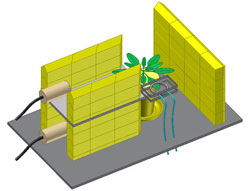After Insects Attack, Plants Bunker Sugars for later Regrowth

Using radioactive short-lived carbon isotopes (11C, with a half-life of 20.4 minutes), scientists have measured transport processes of sugars after plant-insect interaction in wild type and transgenic plants. Image: Dirk Schwachtje
Using radioactive carbon and genetically modified native tobacco plants (Nicotiana attenuata), scientists at Max Planck Institutes in Jena and Golm (Potsdam) and at the Research Centre in Jülich have discovered the first gene mediating tolerance to herbivore attack: GAL83, the beta-subunit of Nicotiana attenuata’s SNF-1 related kinase. This gene mediates a rapid herbivore-elicited carbon-hoarding behaviour in which recently assimilated carbon (measured with 11CO2) is squirrelled away to the roots rather than transported to young expanding leaves, to be used later to extend the period of seed and flower production when the plant is done growing. As soon as the plants are attacked by the larvae of the nicotine-resistant tobacco hornworm, Manduca sexta, elicitors from this herbivore’s mouth (called FACs – fatty acid conjugates), which also tune the plant’s induced defence responses, are shown in this study to activate carbon storage in the roots. By reconfiguring where it stores carbon, the plant gains a measure of tolerance and thereby the ability to withstand voracious herbivores.
Ecological studies conducted in the department of Prof. Ian T. Baldwin at the Max Planck Institute for Chemical Ecology in Jena, Germany, focus on the defense of plants against attack from herbivores. Plants respond to attack by producing an arsenal of direct (toxins, digestibility reducers, etc.) and indirect defences that reduce the attackers' performance, thereby lessening the amount of damage inflicted to the plant. However, the co-evolutionary dynamics of the interaction often leads to herbivores that are adapted to the plant’s defences. Resolution of this evolutionary impasse may require the kind of solution advocated by Mahatma Gandhi: tolerate the damage. Or, with regard to plants: make the necessary physiological adjustments to minimize the fitness consequences of lost tissues. Tolerance may be the best strategy for a plant caught in cycles of defensive escalation with its herbivores to extricate itself.
Wild tobacco, which is native to North America, has developed sophisticated methods to fend off Manduca sexta larvae. For example, jasmonic acid produced after insect attack elicits the emission of volatiles that attract Manduca sexta predators. These insect predators kill caterpillars (Kessler and Baldwin, 2001). Yet even such a complex defense system does not guarantee the plants’ survival. Therefore the plants have developed ways of tolerating defoliation by these insect pests: by bunkering resources in below-ground protected sites when they are attacked – just as humans do in crisis situations. In previous studies, Prof. Baldwin and his colleagues have shown that wild tobacco minimizes the production and transport of the toxin, nicotine, in the leaves when attacked by Manduca sexta, because the value of this defense is reduced against nicotine-adapted attackers. Nitrogen, which is part of nicotine, may be used more effectively in other ways. This seems to apply to carbon, too, which is assimilated from carbon dioxide during photosynthesis. As important energy source, carbon is commonly stored as sugar or starch. The scientists found that molecules in the oral secretions of Manduca sexta larvae activate the downregulation of the expression of a protein kinase activator (GAL83) in the plant tissue via a signalling cascade that remains unknown. GAL83 is not unknown in the animal kingdom and in microorganisms: it is the beta-subunit of a protein complex (SNF1 related kinases), which regulates the use of glucose or galactose in mammals and yeast – especially during times of energy deficiency. SNF1 kinases function as posttranslational modificators and can up- or downregulate the activity of metabolic enzymes by means of phosphorylation.
Prof. Baldwin and his coworkers identified GAL83 when they were examining changes in gene expression in young, photosynthetically active leaves that had been attacked by insect larvae. Using the differential RNA display method, they found remarkably few transcripts (mRNA) of GAL83 in the leaves attacked by insects. With the help of transgenic tobacco plants with constantly downregulated GAL83, they measured the same effect as in the nontransgenic, larvae-infested plants: the increased transport of carbon into the roots, and the utilization of this carbon for seed production at the end of development.
Original work:
SNF-related kinases allow plants to tolerate herbivory by allocating carbon to roots. Jens Schwachtje, Peter E. H. Minchin, Sigfried Jahnke, Joost T. van Dongen, Ursula Schittko, Ian T. Baldwin PNAS (Early Edition) 2006; Vol. 103 (34), 12935-12940
Media Contact
More Information:
http://www.ice.mpg.deAll latest news from the category: Life Sciences and Chemistry
Articles and reports from the Life Sciences and chemistry area deal with applied and basic research into modern biology, chemistry and human medicine.
Valuable information can be found on a range of life sciences fields including bacteriology, biochemistry, bionics, bioinformatics, biophysics, biotechnology, genetics, geobotany, human biology, marine biology, microbiology, molecular biology, cellular biology, zoology, bioinorganic chemistry, microchemistry and environmental chemistry.
Newest articles

Silicon Carbide Innovation Alliance to drive industrial-scale semiconductor work
Known for its ability to withstand extreme environments and high voltages, silicon carbide (SiC) is a semiconducting material made up of silicon and carbon atoms arranged into crystals that is…

New SPECT/CT technique shows impressive biomarker identification
…offers increased access for prostate cancer patients. A novel SPECT/CT acquisition method can accurately detect radiopharmaceutical biodistribution in a convenient manner for prostate cancer patients, opening the door for more…

How 3D printers can give robots a soft touch
Soft skin coverings and touch sensors have emerged as a promising feature for robots that are both safer and more intuitive for human interaction, but they are expensive and difficult…





















